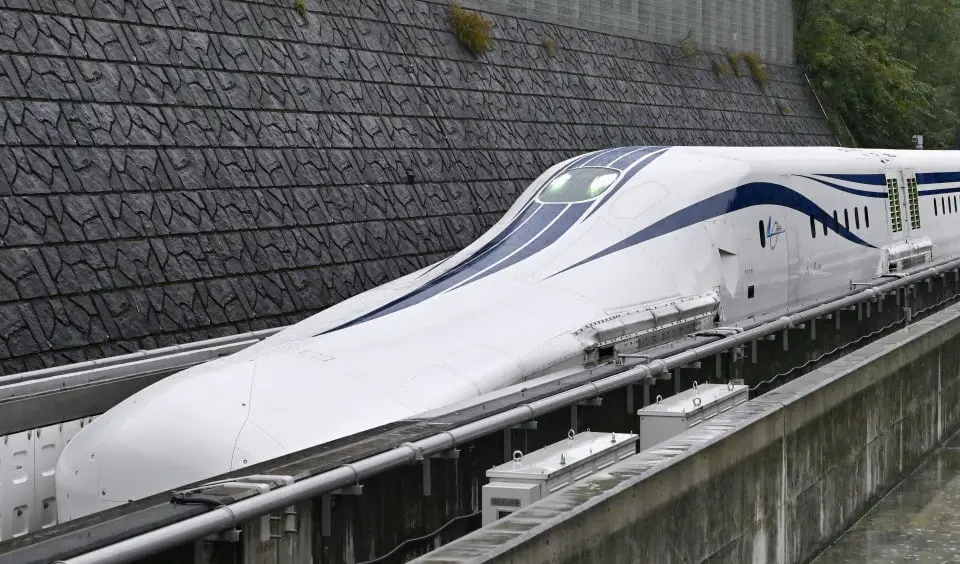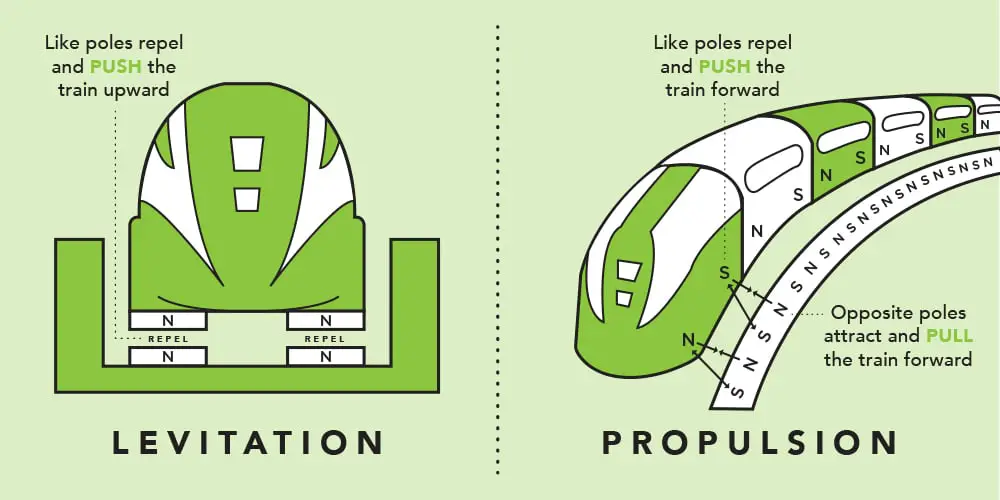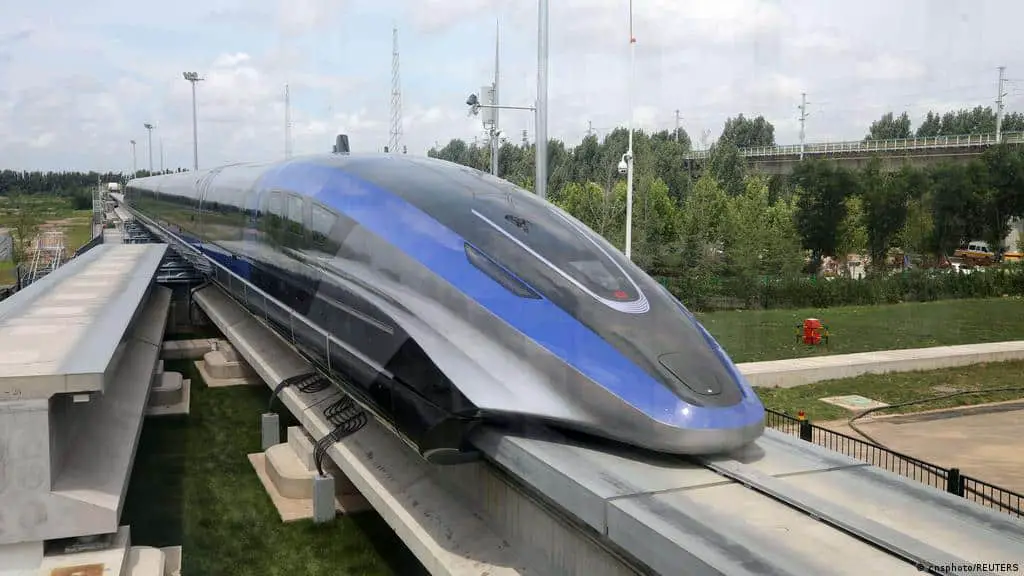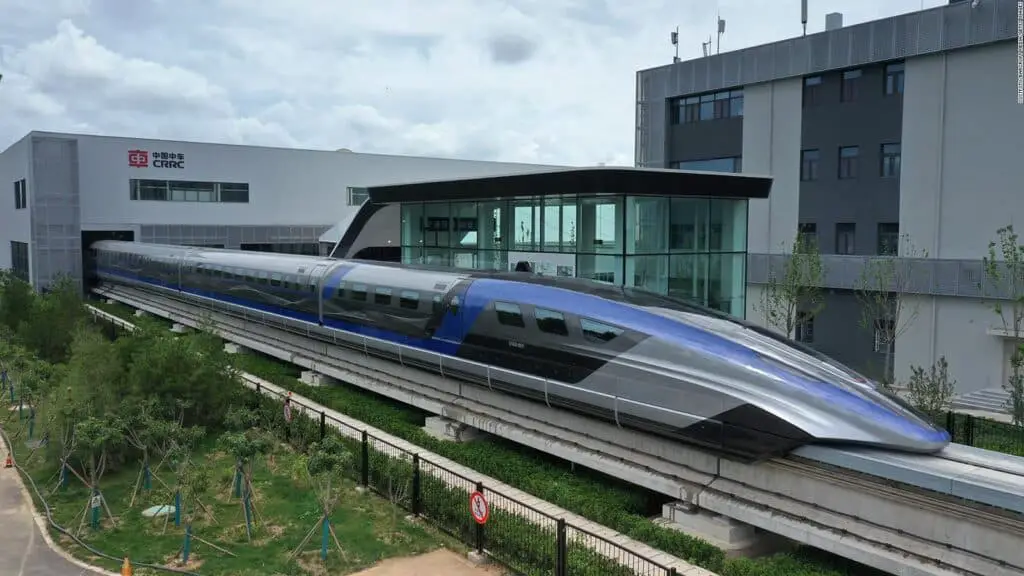Have you heard of the super-fast maglev train? The maglev train is similar to a bullet train, but you can consider it a level up. So, how do maglev trains work, and what makes them super-fast? Read on…
Maglev trains are wheel-less trains that work by using magnetic levitation mechanisms to stay above the track on which they travel. The front corner of this train has the north pole facing out magnets, and the back corners have the south pole facing out magnets. A magnetic field is generated by electrifying the propulsion loops that create a floating magnet design for a smooth trip.

Boom! They are fast, I love these trains, the tech used and the smoothness to their ride, so what is Maglev, find out below.
What Is Maglev? What Does Maglev Mean?
Have you ever seen a train without wheels? Well, such a train exists. This train floats above and glides smoothly without touching a rail instead of rolling along the track. The train travels smoothly from the origin to the destination without coming in contact with the rail. These are called maglev trains (Magnetic Levitation).
It’s basically a futuristic locomotive that offers exciting possibilities for traveling. Compared to the traditional transportation systems, this train is faster, more energy-efficient, and safer.
Currently, only a few maglev trains exist in some selected places mainly China & Japan. But maglev trains will become more common than you think.
Maglev trains do not use wheels. Rather, they are based on magnetic levitation. The trains are levitated a short distance above the track through the strong electromagnets. The magnets are responsible for moving the train as they create thrust.
Maglev trains are known to have superior controls. In addition, its braking doesn’t really depend on the track friction. As this train functions on an interesting concept, its construction cost is high. Currently, three operational commercial maglev systems are present in South Korea, China, and Japan.

History of Maglev Train
The roots of maglev trains can be traced back to the technology pioneer at Brookhaven National Laboratory. In the late 1960s, Gordon Danby and James Powell received the first patent for magnetically levitating trains.
The idea of creating such a train came in a traffic jam when Powell was thinking about a better transportation mode. He then thought to levitate a train car using superconducting magnets (genius) .
Superconducting magnets can be used to increasing the power of magnetic fields. In 2004, the first maglev train working in the superconducting mode opened in Shanghai.
The train cars are suspended above the U-shaped concrete guideway using the superconducting magnets. When the similar poles face each other, the magnets repel.
So How Do Maglev Trains Work – Breakdown
As you know, maglev trains are wheel-less that float on the track. They are faster and safer. These trains use a magnetic mechanism, which keeps them above the track. This mechanism is achieved by three essential parts: levitation, propulsion, and guidance.
Levitation
Levitating refers to the phenomenon that keeps the train suspended above the track. Under the levitating technology, there are two types known as electrodynamic suspension and electromagnetic suspension.
Electrodynamic Suspension
This suspension technique creates a strong magnetic field using superconducting or permanent magnets. The strong magnets levitate the train by producing attractive and repulsive force.
A continuously varying magnetic field is generated through the alternating current of the propulsion coils on the guideway. The rhythm of the alternating coil is continuously changed through the poles of the magnet on the guideway. The changing magnetic field is responsible for guiding the train and moving it forward. The speed of maglev trains can be controlled by changing and altering the current.
Electromagnetic Suspension
Another levitating way is electromagnetic suspension. This is where a magnetic field is exerted using magnets. In this case, the conductors under the guideway attract the train’s levitation magnets. The train is levitated even if the speed is low.
Also, passengers traveling inside the train with a pacemaker or magnetic storage like a hard disk are safe. The magnetic intensity inside the train is minimal and is of no risk. EMS maglev trains come with an emergency power battery supply that keeps the train running in the event of power failure too.
Propulsion
Maglev trains use an electric motor linear that offers propulsion, a force that keeps the train moving forward. Torque and spin, and axle are created through normal electric rotary motors. Here, a rotating piece, the rotor, is surrounded by a stationary piece, the stator.
A rotating magnetic field is generated using a stator. The magnetic field helps the rotor to spin by inducing a rotational force. The rotor is placed on the stator.
Electric linear motion can produce motion in a straight line. It is possible because a stator generates a field instead of a rotating magnetic field that travels down its length. Similarly, the rotor experiences a linear force.
It’s important to remember that the rotor produces liner force only when it’s above the stator. When it reaches the end, it stops.
Guidance
Guidance is a concept that is responsible for keeping the train in the center. It is achieved using repulsive magnetic forces. Two electromagnetic rails facing either side of the guideway are kept on the train in the TransRapid.
Here, the levitating rails are connected. This connection induces a restoring force that helps push the train back to the center if it moves close to one side.

Benefits of Maglev Trains & How They Work
One thing that makes maglev so interesting is its super-fast speed. But that’s not all. A few other qualities also make maglev trains extremely interesting.
Let’s have a look…
Durability
Over time, the conventional rails and wheels undergo great stress. In order to keep them functional, it’s important to replace and repair them periodically. But the maglev train doesn’t go near the guideway. Thus, the possibility of regular wear-and-tear is less.
As the damage is less, the lifespan of this train is comparatively longer than traditional rails. Economically, Maglev trains do not require frequent maintenance.
Note: Beautiful wooden railroad ties are phased out and not used with this type of train or tracks.
Safety
As maglev trains travel so fast, you would think that their safety would be an issue. But surprisingly, these trains are safer than you think, as they are impossible to derail. A complete guideway collapse can move the train from its track, but this an extremely rare occurrence.
In addition, the weather is also not an issue as these trains do not roll along the track. So, factors like rain, snow, or ice have little to no effect. Furthermore, the possibility of a train hitting items on the track are eliminated as they are above the ground!
Energy Efficient
Maglev trains are not known to lose any energy to friction. It makes the train energy efficient. As the train has an efficiency advantage, operation costs for power are less making it a more environmentally friendly transport option.
Environmental Impact
Compared to the high-speed rails, maglev trains can make higher turns. It helps navigate terrain much better. The constructed guideway is engineered in the best possible way, so it has little effect on the environment when it comes to running/laying tracks.
Unlike traditional rails, guideways take up less space. In addition, guideways can also be quickly elevated off. For this reason, animals and plants can live safely with trains traveling above them.
Noise Pollution
Noise pollution is an essential factor in any transportation project. As maglev trains travel smoothly from the origin to the destination without coming in contact with the rail, they are quieter. It’s another advantage of the Maglev train over the traditional train.
How do Maglev trains compare with what we currently have in the U.S?
You can compare how fast a maglev train goes compare to how fast a train goes in the U.S here.

Drawbacks of Maglev
Ok, there are some drawbacks, but not many…
The maglev train is a futuristic locomotive, it cannot be built everywhere. One of the biggest factors is the incompatibility of guideways with the existing rail infrastructure.
For this reason, any country willing to install Maglev trains needs to begin the process from the beginning. Constructing entirely new sets of tracks is a costly affair, and it requires a very high initial investment.
While maglev trains are fast many countries are not ready to spend a large amount on them because it is slightly better than the high-speed rails they already have, they payoff is not great enough to justify the initial outlay.
Maglev trains cannot be classed as an all round superior alternative to current high speed rail networks. Yes, they are faster, yes they are safer and have less ongoing wear and tear. But, there is a much higher initial setup and production cost of train and tracks.
How Do Maglev Trains Work – Conclusion
The Maglev is a favourite of mine, in summary, it is a special class of high-speed train that functions on the magnetic levitation mechanisms to stay above the track they travel. The train does not come in contact with the rail, making it faster and safer.
It works on two different levitating mechanisms called electrodynamic suspension and electromagnetic suspension. But maglev trains cannot be implemented everywhere as existing rail is not compatible with the guideways.
Currently there are none in the U.S, but both China and Japan are swiftly moving forward with Maglev technology as is South Korea.
I hope i’ve answered your question ” how do Maglev trains work. If you feel like a train journey, not as fast as a Maglev, but absolutely beautiful, take a look at our take on the Amtrak Cardinal review.

